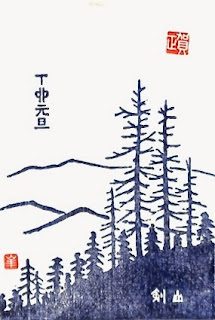When I received his New Year’s block print greeting card in the U.S., I was quite thrilled and excited. I loved it. Perhaps I was yearning for a taste of Japan I seldom encountered after settling in San Diego in Southern California. For quite a while, I did not exchange letters with even close friends from the previous workplace, but I reciprocated with this innocent stranger, although it was just an annual exchange of New Year's cards over the Pacific Ocean. For some decades, time drifted by so quickly, now that I look back.
The motif of his block prints were mostly in the rich local colors of Tokushima culture, except for a few exceptions. I lost quite a few prints during my relocation within the United States and return to Japan. The exceptions included cards with full print Chinese characters to celebrate the year of his 77th birthday, and a few animals - horse and tiger, from the 12 horary signs. In regards to his association with Tokushima, I thought he was sent back to the local branch of his employer, but perhaps in a few years he was recalled back to Tokyo.
I have a special attachment to Tokushima. Tokushima is where my mother-in-law was born. She belonged to the Taira Clan fugitive Samurai tribal village. Their surnames, like Baba (horse riding ground) and Iba (archery ground) sound intimidating (I had to deal with them after getting married). After facing defeat at the Battle of Yashima (now Takamatsu) in 1185 at the hands of the Genji Clans, the Babas and Ibas fled and lived hidden in the deep mountain valley close to the Iyadani Gorge, far, far away from any town.
Today, Iyadani is a famous hot spring resort and there's a rare suspension bridge made of vines (replaced with a new one every three years). It is a gateway to Mt. Tsurugi (Sword Mountain, elev. 1995 m), one of the highest mountains in Shikoku, along with Mt. Ishizuchi (Stone Hammer, elev. 1982 m) in Ehime Prefecture, both regarded as holy mountains and for asceticism. I climbed Mt. Ishizuchi when I was in junior high school. The Iya River flows into the mighty Yoshino River and into Tokushima City where my Tokushima friend (of block prints) worked.
Displayed here are a few of his block prints:
Tokushima Awa Dancers; Heads of Awa Puppet Dolls (one Naozane Kumagai, Genji Clan warrior, who slew a teenaged Taira Clan commander Atsumori Taira, a nephew of Kiyomori Taira in the battle, and entered into priesthood to mourn for the victim, and the other, Otsuru, a girl pilgrim looking for her parents); Mt. Bizan (shaped like an eyebrow from any angle, elev. 280 m) in the center of Tokushima City; Gokurakuji-Temple, second of the 88 Shikoku temples for the Henro pilgrimage; Mt. Tsurugi already mentioned as above, and last, but not least, a German Bridge. I have visited WW1 German POW Bando Camp and wrote a blog entry about it. I wish to add that German prisoners built this small memorial stone bridge inside the yard of a nearby shrine to show their appreciation to the Bando community as a token of gratitude for the warm reception before leaving. I heard a total of 3,000 stones, weighing 200 tons were used. For more information, you can visit the excellent Facebook Guide “Discover Tokushima.”
When I tried to contact him upon my visit at Tokushima Toastmasters, he had already left. Late last year I received an obituary notice from his wife. I sent my condolences and told her how I loved his block prints. She sent me his photograph and told me that the block printing was his hobby. He always carried his sketch book and engraved wood blocks based on his sketches.
The block print friend’s name was Dr. Toshio Shoman, Professor Emeritus, former faculty member of Engineering at Tokushima University. The pen name Dr. Shoman engraved in red on the block prints was 峯 “Hou” or Feng in Chinese. When I asked about it, Mrs. Shoman wrote back that his pen name was 雄峯 but used only one character for abbreviation. He was born in Toyama and his favorite home town memory was of the snow capped 雄山 Yusan (Xiongshan), elevation 3,000 meters.
A further note regarding Tokushima University - In February 2015, the media reported on Tokushima University receiving a donation from Dr. Shuji Nakamura, now a professor at University of California, Santa Barbara, for half of the Nobel Prize money he received for his LED invention. Dr. Namamura was quoted as saying, "I owe my initial basic research to my alma mater university equipment and I hope my donation will serve for future Nobel worthy inventions." Tokushima University suddenly rose up in fame.













